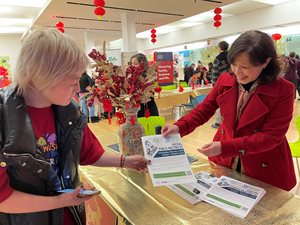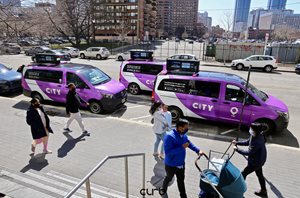January 2023
Posted: 1/26/2023 12:15:40 PM
 Six additional community members, from a variety of interesting backgrounds, have been recruited to participate in the second year of the NJTPA’s innovative pilot Outreach Liaison Program. Two previous participants also are continuing with the program, which kicked off in 2021. Profiles of the eight liaisons are here.
Six additional community members, from a variety of interesting backgrounds, have been recruited to participate in the second year of the NJTPA’s innovative pilot Outreach Liaison Program. Two previous participants also are continuing with the program, which kicked off in 2021. Profiles of the eight liaisons are here.
Participants receive training about the NJTPA and conducting outreach and then go on to serve as trusted advocates, leveraging their community connections to help to gather public input for various projects and programs across the region.
The Outreach Liaison Program is intended to increase diversity, inclusion, and participation of groups that have been traditionally under-represented in transportation planning work. The new recruits include individuals with experience working with low-income families, senior citizens and care givers, individuals with disabilities, children, minorities, and those with limited English proficiency.
Outreach liaison activities might include attending community events on behalf of the NJTPA, distributing information about projects or public surveys, organizing and conducting community conversations, or sharing information through their social media and other online networks. Outreach liaisons who are bilingual may also provide translation services.
In the program’s first year, NJTPA outreach liaisons helped engage the public in the development of a Regional Active Transportation Plan, which will be completed this year and aims to establish a safe and functional regional network of pedestrian and bicycle facilities. Outreach liaisons have also helped promote subregional studies in Essex and Somerset counties.
Beyond providing the NJTPA with valuable insights for its projects and programs, outreach liaisons also gain valuable skills in networking, communication, event planning, meeting facilitation, and public outreach and engagement techniques. Participants are required to live in the 13-county NJTPA region and receive a stipend for their time.
The NJTPA is conducting the Outreach Liaison Program with support from the Public Outreach and Engagement Team at Rutgers University’s Voorhees Transportation Center. To learn more about the program visit www.njtpa.org/OutreachLiaisons.
Posted: 1/17/2023 1:15:58 PM
David Antonio, Essex County’s Director of Planning, and Andras Holzmann, Supervising Planner for Passaic County’s Department of Planning, were elected to two-year terms as chair and vice chair of the NJTPA’s Regional Transportation Advisory Committee (RTAC), respectively, during its meeting Monday.
Antonio, who has represented Essex County on the Committee for more than 20 years, replaces Mark Jehnke, Assistant Ocean County Engineer, who served two terms as RTAC chair. Holzmann, who replaces former Hudson County Supervising Planner Byron Nicholas, has represented Passaic County on RTAC for more than two years. Prior to joining Passaic County, Holzmann previously worked for Somerset County and served on RTAC in that capacity.
RTAC is comprised of technical staff (planners, engineers) from each of the NJTPA’s 15 subregions — the 13 counties in northern and central New Jersey and the cities of Jersey City and Newark — as well as representatives from NJ TRANSIT, the New Jersey Department of Transportation, the Governor’s Office, and the Port Authority of New York and New Jersey.
Jehnke’s strong leadership and friendly, collaborative approach helped RTAC navigate through the many difficulties of the pandemic. He was thanked by NJTPA staff for remaining on as RTAC chair through a second term, providing critical continuity amid the challenges of virtual meetings and presentations. Jehnke will continue to represent Ocean County on the Committee.
The committee’s next meeting is scheduled for February 14.
Posted: 1/11/2023 3:09:57 PM
The NJTPA’s Board of Trustees is transitioning back to in-person meetings, beginning with the March 2023 meeting.
“In-person meetings provide more opportunities for Board members and staff to collaborate and share ideas, and they allow us to interact with members of the public, who come to speak about the items we are voting on and other matters,” Chair John Bartlett, a Passaic County Commissioner, said at Monday’s meeting.
This will be the first in-person meeting since the Board moved to a virtual format during the pandemic in March 2020.
Chair Bartlett noted that the decision to return to in-person meetings was made after polling members of the Board.
“While there were mixed responses on whether we should continue with virtual or in-person Board meetings, there was consensus that there is value in meeting face-to-face,” he said.
Committee meetings will continue to be held virtually, based on the poll results.
Chair Bartlett noted that if there is inclement weather or a public health reason, the Board could shift to a virtual meeting.
Board meetings will continue to be livestreamed on the NJTPA’s website and YouTube channel.
Board and committee meetings are open to the public. For additional information on how the public can participate visit https://njtpa.org/publiccomment.
Posted: 1/11/2023 1:53:22 PM
Jersey City is one of several municipalities across the country to launch an on-demand transportation service to address gaps and connect to a vast public transit network that includes NJ TRANSIT buses and light rail, PATH and ferries.
The City partnered with Via to launch the service two years ago. The
New York City-based transportation technology company works with more than 600 public entities and facilitates 2.5 million shared rides each month. Eric Gardiner, East Coast partnerships director, told the NJTPA Board of Trustees
during a presentation Monday.
Gardiner said microtransit is best used to:
- Fill gaps where fixed-route network is limited, especially fixed route as an artery
- Complement fixed route with first- and last-mile solutions
- Convert underperforming fixed routes into on-demand services
- Increase mobility for seniors or disabled riders
Sometimes called on-demand transit, microtransit is technology-enabled transportation that uses real time, on-the-ground information to group passengers into shared rides based on traffic and where rides are being requested, Gardiner said. (The latest issue of NJTPA’s
InTransition biannual magazine, examined microtransit efforts around the country.)
There are two models that Via offers:
- Licensing software to transit agencies and operators who prefer to use their own vehicles and drivers.
- A turnkey solution operated on behalf of partners that includes technology, drivers and vehicles, which is how it’s used in Jersey City.
 In Jersey City, Via’s 44 Mercedes vans (
In Jersey City, Via’s 44 Mercedes vans (eight are wheelchair accessible) and two electric vehicles cover a service zone of 15 square miles on weekdays from 6 a.m. to 10 p.m. and Saturdays from 8 a.m. to 10 p.m. Six of 10 trips connect to transit and 70 percent of rides are shared, according to Gardiner.
Since Via Jersey City launched in early 2020, it’s provided more than 1.25 million rides, averaging 57,000 per month or around 2,000 rides per day. In the third quarter of 2022, Gardiner estimated that Via helped to avoid more than 300,000 miles of single-occupancy vehicle (SOV) driving.
There have been questions about whether on-demand microtransit cannibalizes existing fixed-route services and if privatization is the answer for improving public transportation. Analysis by Via showed that less than 25 percent of trips taken by the service could have been served by existing transit services. “Via Jersey City is really showing that it’s enhancing, not taking away from, fixed-route services,” Gardiner said.
Jersey City also plans to integrate public transit service into its app, allowing riders to choose public transportation over Via, or see where they could connect a Via ride to transit.
.jpg.aspx?width=375&height=249) This city is spli
This city is split into two zones, a center zone concentrated around the downtown and an outer zone. Fares are $2.50 anywhere from the center zone to the outer zone; beyond the outer zone is an additional $0.50 per mile. Given the geography of Jersey City, fares don’t tend to be more than $5, he said. These fares cover only a portion of actual costs which in 2021 were $11.61 per ride, according to Gardiner.
More than half of users report a household income of less than $50,000, according to Gardiner, while 88 percent identify as minorities, 58 percent as women, and 68 are under the age of 35. Michael Manzella, Jersey City’s Director of Transportation, said Via is serving the exact population it was expected to, with ridership growing about 23 percent from 2021 to 2022 and approaching five passenger rides per hour.
The program is helping Jersey City meet other goals, including improving safety by reducing automobiles on the road, Gardiner said.
“The fact that people are able to access the service for the first and last mile is probably reducing pedestrian crossings at roadways and increasing pedestrian safety,” NJTPA Board Chair John W. Bartlett added.
Arjun Janakiram, Via’s funding policy researcher, said there are several federal funding programs that communities could use to create microtransit programs, including:
- Carbon Reduction Program: $1.28 billion per year ($13.5 million allocated to northern New Jersey), which can be used for on-demand transportation service technology.
- Congestion Relief Program: $50 million per year, which can be used for on-demand microtransit. The notice of funding opportunity is expected to be issued in the coming months.
- Rural Transportation Program: $300 million to $500 million per year, which can be used for an integrated mobility management system and on-demand mobility services.
- Advanced Technologies Program: $60 million per year, which can be used for on-demand transportation service.
Jersey City subsidizes its program to keep fares affordable but has received grants to support its Via program, including $600,000 from the state Department of Environmental Protection to further electrify the fleet and $250,000 from the federally-funded NJ-Job Access and Reverse Commute program administered by NJ TRANSIT. The city has also generated $100,000 in revenue from advertising on the interior and exterior of Via vehicles.
A recording of the presentation is available here.